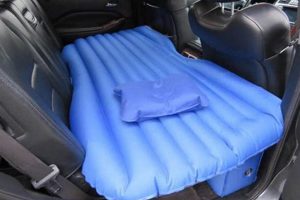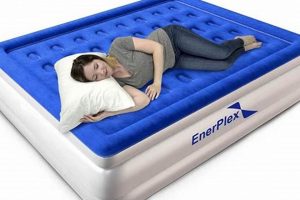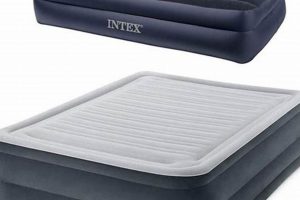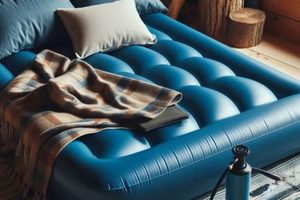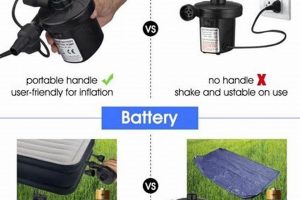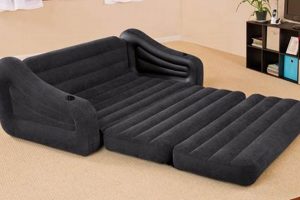A portable inflatable bed designed for convenient storage and transport represents a practical solution for temporary sleeping arrangements. These beds generally consist of an inflatable air chamber encased in a durable fabric or plastic, often incorporating a folding mechanism that allows it to be compacted when not in use. For example, a guest might use one in a home lacking a spare bedroom, or a camper might utilize it for a more comfortable sleeping surface outdoors.
The compact nature of these sleeping solutions offers considerable advantages. They address space constraints in smaller living environments and provide a readily available sleeping surface when unexpected guests arrive. Historically, simpler versions of inflatable mattresses have been used for camping and recreation. Modern iterations incorporate improved materials, construction techniques, and integrated inflation systems, enhancing durability and ease of use. These advancements have expanded their applications beyond recreational use, making them suitable for temporary housing and disaster relief efforts.
The following sections will delve into the construction materials, inflation methods, comfort considerations, size variations, and storage recommendations associated with selecting an appropriate portable and collapsible sleeping surface. This analysis will offer a comprehensive guide for individuals seeking a versatile and space-saving sleeping solution.
Tips for Selecting and Maintaining a Folding Air Mattress
This section provides practical advice on choosing and preserving the integrity of a portable inflatable sleeping solution to ensure longevity and optimal performance.
Tip 1: Assess Material Durability: Examine the construction material for tear resistance and puncture resistance. Look for reinforced seams and a thick gauge PVC or similar material, especially if intended for outdoor use.
Tip 2: Evaluate Inflation/Deflation Mechanism: A built-in pump streamlines the inflation process. Consider models with rapid inflation and deflation capabilities to minimize setup and storage time. Verify the pump’s power source compatibility.
Tip 3: Consider Size and Weight Capacity: Select a size appropriate for the intended user and space limitations. Adhere strictly to the weight capacity specified by the manufacturer to prevent structural damage and ensure user safety.
Tip 4: Prioritize Comfort Features: Look for models with integrated pillow tops or flocked surfaces to enhance sleeping comfort. The internal coil structure or air chamber design affects overall support. Research and choose accordingly.
Tip 5: Inspect Valve Integrity: Before each use, inspect the inflation valve for leaks or damage. A compromised valve will prevent the unit from maintaining consistent air pressure throughout the night.
Tip 6: Practice Proper Storage Techniques: Thoroughly clean and dry before storage. Fold tightly to minimize space and prevent abrasion. Store in a cool, dry location away from direct sunlight to prevent material degradation.
Tip 7: Use Protective Bedding: A mattress protector or fitted sheet can shield the surface from dirt, stains, and potential punctures, extending the lifespan of the inflatable bed.
By adhering to these guidelines, users can maximize the utility and extend the functional life of a portable inflatable bed, ensuring a comfortable and reliable temporary sleeping solution.
The subsequent sections will provide information regarding cleaning and repair procedures to further prolong its usefulness.
1. Portability
The concept of portability is intrinsically linked to the utility and design of a collapsible inflatable bed. This feature distinguishes it from conventional mattresses and fixed sleeping arrangements. Portability enables users to transport the bed easily to various locations, including guest rooms, camping sites, or temporary shelters. The folding mechanism is designed to reduce the overall volume and weight, making it easier to carry and store. The cause is the need for a flexible sleeping solution; the effect is the product’s inherent design for convenient relocation. The importance of portability lies in its ability to provide a comfortable sleeping surface in situations where traditional bedding is unavailable or impractical. For example, disaster relief organizations rely on the portability of these beds to provide temporary housing solutions for displaced individuals.
Further enhancing portability is the inclusion of features such as integrated carrying bags or handles. These additions facilitate transportation and protect the inflatable bed from damage during transit. The practical application extends beyond recreational use. Homeowners with limited storage space benefit from the compact nature of these mattresses when not in use. Furthermore, individuals moving frequently appreciate the ease with which these beds can be packed and moved, eliminating the need for professional moving services for bulky furniture. For example, college students frequently utilize this type of mattress for its combination of affordability and compactness.
In summary, portability defines the core functionality of a collapsible inflatable bed. This characteristic addresses the need for a readily transportable and easily storable sleeping solution. Challenges related to maintaining durability while optimizing portability are continuously addressed through advancements in material science and design engineering. The focus remains on delivering a comfortable and reliable sleeping surface without compromising the ease of transport that defines the product’s value proposition.
2. Inflation Mechanism
The inflation mechanism is an integral component of any portable inflatable bed, dictating ease of setup, functionality, and user convenience. Without a functional inflation mechanism, the mattress remains unusable. Inflation mechanisms cause the bed to inflate, providing a sleepable surface. This is a critical consideration. The inflation method directly impacts the practical viability of the inflatable bed. For example, a slow or unreliable inflation system renders the product less appealing to campers or those seeking a quick sleeping solution for unexpected guests. Therefore, the cause leads to a practical significance when understanding the mechanisms.
Various inflation mechanisms exist, each offering different advantages and disadvantages. Integrated electric pumps offer the most convenience, providing rapid inflation with minimal user effort. However, they require a power source, limiting their usability in off-grid locations. Battery-operated pumps address this limitation but require regular battery replacements. Manual pumps, while requiring more physical effort, offer independence from external power sources and are more reliable in remote environments. The choice of mechanism thus depends on the intended use and envi
ronmental constraints. Understanding the differences allows users to select an inflatable bed with a suitable inflation system for their specific needs.
The reliability and efficiency of the inflation mechanism are crucial for a positive user experience. Slow or faulty pumps can be frustrating and negate the portability benefits of the bed. Leak-proof valves are equally essential for maintaining consistent air pressure throughout the night, ensuring a comfortable sleeping surface. The interaction between material strength and efficient inflation is fundamental to product longevity and user satisfaction. Ongoing innovation in pump technology and valve design continues to refine the product category, addressing limitations and enhancing the overall practicality of collapsible inflatable beds.
3. Storage Footprint
The concept of storage footprint directly influences the practicality and utility of any collapsible inflatable bed. Minimizing the space required for storage is a primary advantage over conventional mattresses, particularly in space-constrained environments. The effectiveness of the folding mechanism and the material properties significantly impact the final packed size, thus influencing the overall storage footprint.
- Compressed Dimensions
The compressed dimensions represent the physical size of the collapsed inflatable bed when not in use. These dimensions dictate the ease with which the bed can be stored in closets, attics, or vehicle cargo areas. Smaller compressed dimensions translate to enhanced storage versatility and greater convenience for users with limited space. The achievable compressed dimensions are contingent upon the design of the folding mechanism and the compressibility of the materials used in construction. For example, models employing tightly folding designs and lightweight, pliable materials exhibit smaller packed sizes compared to those utilizing bulkier materials or simpler folding methods.
- Weight Considerations
Although technically not a dimension of the “footprint,” the weight of the packed inflatable bed influences its ease of handling and storage. A lighter bed is easier to lift and maneuver during storage, especially for individuals with mobility limitations. Heavy models can present challenges when storing on upper shelves or transporting over longer distances. Therefore, manufacturers often prioritize lightweight materials to minimize both the storage footprint and the overall weight, improving the product’s accessibility and usability. A lighter weight also allows for more storage placement options within a home.
- Storage Bag Design
The design of the storage bag significantly affects the ease and efficiency of packing and storing the collapsible inflatable bed. A well-designed bag should be durable, appropriately sized, and incorporate features that facilitate compression and secure closure. Bags with compression straps, for instance, enable users to further reduce the packed size. A poorly designed bag can make packing cumbersome and increase the risk of damage to the inflatable bed during storage. The material of the bag is also important. A rugged material protects the mattress from dirt, moisture, and potential punctures during storage.
- Environmental Factors in Storage
The environmental conditions in the storage location can affect the integrity of the inflatable bed and its storage footprint over time. High temperatures, humidity, and direct sunlight can degrade the material and compromise the air-holding capacity. Selecting a cool, dry storage location away from direct sunlight is crucial for prolonging the lifespan of the bed. Similarly, storing the bed near sharp objects or in areas prone to pest infestation can increase the risk of damage. A proper storage environment helps to maintain the beds condition, preventing premature wear and tear and thus indirectly influencing its long-term usability and storage footprint.
In summary, the storage footprint is a critical attribute that directly impacts the value proposition of a collapsible inflatable bed. The compressed dimensions, weight considerations, storage bag design, and environmental factors all contribute to the overall storage convenience. Optimizing these factors is essential for creating a product that effectively balances portability, comfort, and space-saving features.
4. Material Strength
Material strength is a paramount consideration in the design and functionality of collapsible inflatable beds. It directly influences the product’s durability, lifespan, and ability to withstand repeated use and storage. The choice of materials determines the inflatable bed’s resistance to punctures, tears, abrasion, and degradation from environmental factors. Without adequate material strength, the utility and longevity of the inflatable bed are severely compromised.
- Tensile Strength of the Outer Shell
The tensile strength of the outer shell material dictates the inflatable bed’s ability to resist stretching and tearing forces. This is particularly important during inflation and when subjected to the weight of a user. Materials with high tensile strength, such as reinforced PVC or polyester fabrics, are better equipped to withstand these stresses, reducing the risk of seam failures or punctures. For example, a model constructed with a durable, multi-layered fabric can support a significantly higher weight load and maintain its shape more effectively than one made with a thinner, less robust material. High resistance to stretching can also prevent air leaking, thus allowing the bed to maintain constant air pressure during use.
- Puncture Resistance of the Air Chamber
The air chamber’s puncture resistance is crucial for maintaining inflation and preventing air leaks. Materials used for the air chamber must be resistant to sharp objects and abrasion. Multi-layered materials or those with a reinforced coating provide enhanced puncture resistance. For instance, some models incorporate a puncture-resistant layer between the outer shell and the main air chamber to minimize the risk of damage from accidental contact with sharp objects. This layer is essential, especially if the mattress is used outdoors or on surfaces that may contain debris.
- Seam Strength and Construction Techniques
Even with high-strength materials, weak seams can compromise the structural integrity of the collapsible inflatable bed. Seam strength depends on the type of stitching used, the quality of the thread, and the bonding technique employed. Reinforced seams, achieved through techniques like double stitching or heat welding, provide greater resistance to tearing and air leaks. High-quality seam construction ensures that the inflatable bed can withstand repeated inflation, deflation, and folding without compromising its structural integrity. For example, a model with heat-welded seams offers a more airtight and durable seal than one with simple stitched seams.
- Resistance to Environmental Degradation
Exposure to environmental factors, such as sunlight, moisture, and temperature fluctuations, can degrade the materials used in collapsible inflatable beds over time. UV radiation can cause discoloration and weakening of the outer shell, while moisture can promote mold growth and material breakdown. Selecting materials with inheren
t resistance to these factors or applying protective coatings can extend the lifespan of the inflatable bed. For example, some models are treated with UV inhibitors to prevent sun damage, while others utilize waterproof coatings to protect against moisture ingress. These treatments are essential for ensuring that the inflatable bed remains functional and aesthetically appealing over extended periods, especially when stored or used outdoors.
The correlation between material strength and the overall performance of a collapsible inflatable bed is undeniable. From tensile and puncture resistance to seam integrity and environmental stability, material properties directly influence the durability, comfort, and lifespan of the product. Manufacturers continuously strive to incorporate advanced materials and construction techniques to enhance material strength, thereby providing users with a reliable and long-lasting sleeping solution.
5. Comfort Level
Comfort level constitutes a critical factor in the assessment and selection of a collapsible inflatable bed. The perceived comfort of the sleeping surface directly impacts user satisfaction and the overall utility of the product. Several design elements and material choices converge to determine the final comfort level. The cause of discomfort on an air mattress is often linked to uneven support, inadequate cushioning, and temperature regulation. The effects manifest as restless sleep, pressure point pain, and dissatisfaction with the sleeping experience. Comfort is thus a leading indicator of the success, or failure, of the mattress’s function.
Factors contributing to the comfort level include the internal structure of the air chamber, the surface material, and the presence of additional features. Internal coil structures, for example, distribute weight more evenly, mimicking the support provided by traditional spring mattresses. Flocked surfaces enhance comfort by reducing friction and improving temperature regulation, preventing the sticky or cold sensation often associated with bare PVC. Some models incorporate integrated pillow tops or memory foam layers to provide additional cushioning and contouring support. The practical application of these features translates directly to improved sleep quality and user satisfaction. Consider, for instance, an individual using a collapsible inflatable bed as a temporary sleeping solution after a home renovation; a higher comfort level can mitigate the disruption to their normal sleep patterns. Another example is a camper who would have an improved overall satisfaction of their camping trip, which can be attributed to comfort when using this mattress.
Ultimately, the comfort level of a collapsible inflatable bed is a subjective but essential attribute. While portability and ease of storage are key advantages, these features are rendered less valuable if the sleeping surface is uncomfortable. Manufacturers continually innovate with new materials and design techniques to enhance the comfort level of these mattresses, bridging the gap between convenience and quality sleep. A challenge that remains is the balance between achieving a high level of comfort while maintaining portability and affordability. However, the focus on improving comfort reflects the growing demand for collapsible inflatable beds that offer a truly viable alternative to traditional sleeping arrangements.
6. Weight Capacity
The weight capacity of a folding air mattress is a critical specification directly impacting its safety, performance, and lifespan. This rating, typically expressed in pounds or kilograms, indicates the maximum distributed weight the mattress can support without structural failure or significant loss of air pressure. Exceeding the stated weight capacity can lead to seam rupture, material stretching, or even complete mattress collapse. For example, if a folding air mattress is rated for 300 pounds and is consistently used by individuals weighing 350 pounds, the likelihood of premature failure increases substantially.
Weight capacity is intricately linked to the materials used in the mattress’s construction and its internal support structure. Higher weight capacities necessitate stronger, more durable materials, reinforced seams, and potentially more complex internal baffling systems to distribute weight evenly. A folding air mattress designed for a single user will generally have a lower weight capacity than one intended for two adults. Misunderstanding or disregarding the weight capacity can result in an uncomfortable sleeping experience, reduced mattress longevity, and, in extreme cases, injury. Furthermore, consistently overloading the mattress may void any warranty offered by the manufacturer.
Understanding and adhering to the weight capacity of a folding air mattress is essential for safe and effective use. Choosing a mattress with an appropriate weight capacity for the intended user(s) ensures optimal support, minimizes the risk of damage, and extends the lifespan of the product. The weight capacity functions as a critical safety parameter, preventing potential hazards and contributing to a positive user experience. Prior to purchase and use, the manufacturer’s weight capacity rating should be carefully reviewed.
Frequently Asked Questions Regarding Folding Air Mattresses
The following section addresses common inquiries concerning the selection, usage, and maintenance of collapsible inflatable beds.
Question 1: What is the typical lifespan of a folding air mattress?
The lifespan of a folding air mattress varies significantly based on material quality, frequency of use, and adherence to proper storage guidelines. With regular use, expect a lifespan of approximately 1-3 years. Infrequent use and diligent care can extend this period.
Question 2: Can a folding air mattress be used as a permanent bed?
While possible, utilizing a folding air mattress as a permanent bed is not recommended. These mattresses are primarily designed for temporary use. Sustained use can lead to accelerated wear and diminished support, potentially impacting sleep quality.
Question 3: How should a folding air mattress be properly stored?
Prior to storage, ensure the mattress is thoroughly deflated, cleaned, and dried. Fold the mattress tightly and store it in a cool, dry location away from direct sunlight and sharp objects. Ideally, use the original storage bag to protect the material.
Question 4: What is the best way to repair a puncture in a folding air mattress?
Small punctures can often be repaired using a vinyl repair kit commonly available at sporting goods stores. Clean the area around the puncture, apply the adhesive, and adhere to the patch according to the kit instructions. Allow sufficient drying time before reinflating.
Question 5: Are all folding air mattresses suitable for outdoor use?
Not all models are designed for outdoor use. Examine the product specifications to determine if the mattress is constructed from durable, puncture-resistant materials suitable for outdoor environments. Some models may require additional protection from rough surfaces.
Question 6: What factors should be considered when selecting a folding air mattress for guests?
Consider the mattress size, weight capacity, and comfort features, such as flocked surfaces or built-in pillows. Ease
of inflation and deflation is also important. Choose a model that meets the needs of the anticipated user(s) and fits within the available space.
Proper care and informed selection contribute significantly to the performance and longevity of a folding air mattress. Addressing these key questions provides a solid foundation for responsible ownership.
The following segment will provide a comparative analysis of different folding air mattress models and brands.
Conclusion
This exposition has explored the multifaceted aspects of the folding air mattress, encompassing its design, material composition, inflation mechanisms, storage considerations, comfort parameters, and weight capacity. A comprehensive understanding of these elements is critical for informed purchasing decisions and optimal utilization of this portable sleeping solution. The balance between portability, durability, and comfort remains central to the value proposition of these mattresses.
The ongoing advancements in materials science and design engineering promise further enhancements in the functionality and longevity of folding air mattresses. Consumers are encouraged to carefully evaluate their specific needs and intended uses when selecting a model, ensuring alignment with the discussed parameters for a satisfactory and reliable sleeping experience. The continued innovation within this product category indicates an expanding role for the folding air mattress in diverse temporary sleeping scenarios.


